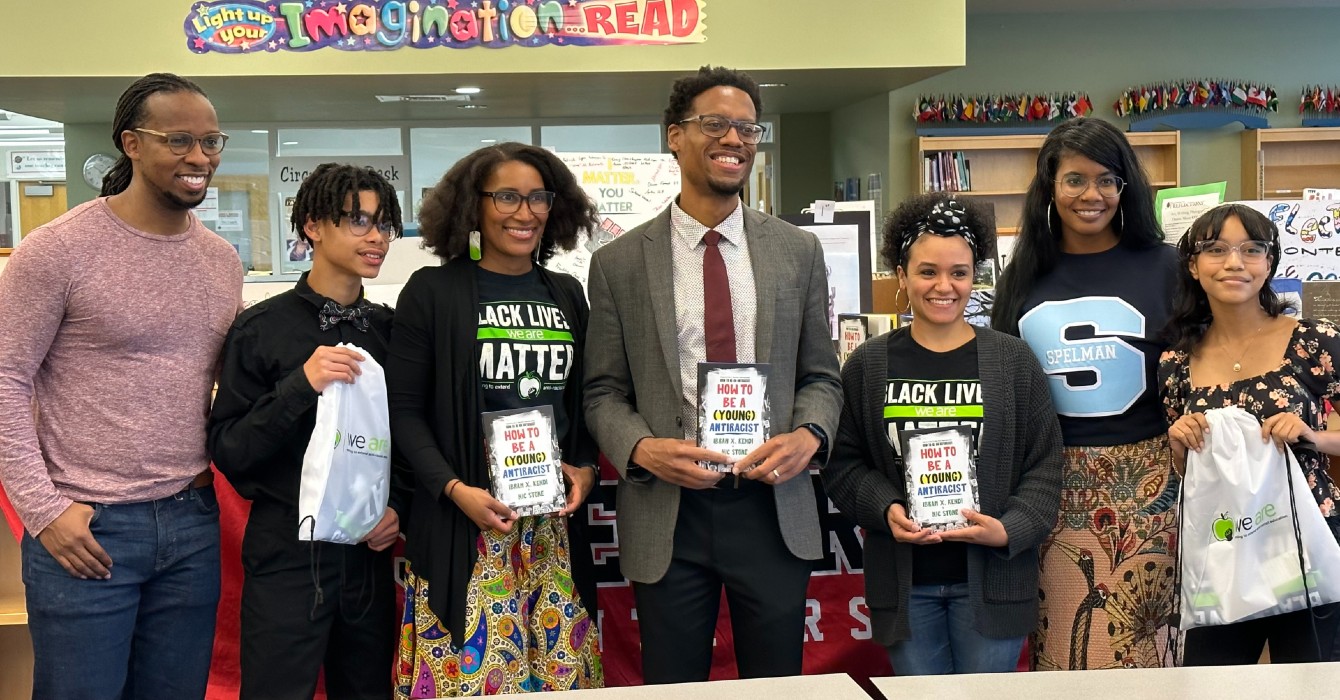On the same day that mourners gathered for the funeral of Tyre Nichols, a group of mostly Black students at a Durham, North Carolina, middle school more than 700 miles away got a lesson about anti-racism.
The eighth graders, assembled in the auditorium of Shepard Magnet Middle School, heard from two celebrated anti-racist activists: the historian Ibram X. Kendi and the writer Nic Stone.
The two speakers did not bring up Nichols, who died from injuries sustained in a savage beating by police in Memphis, Tennessee, after being stopped for an alleged traffic violation. His death has sparked renewed anguish over racism and police brutality in America. But Kendi and Stone did try to help students consider how racism permeates society and what they can do to be anti-racist.
Their appearance was part of a 10-day book tour launching “How to Be a (Young) Antiracist,” a teen adaptation of Kendi’s widely acclaimed 2019 social commentary and memoir, “How to Be an Antiracist.” Stone is the author of several highly regarded young adult and middle school novels, including “Dear Martin.”

They collaborated on the newest book released last week by Kokila, a young readers imprint of Penguin Random House. This version comes not only as the nation grapples with Nichols’ death but also amid a very public pushback against accurately teaching America’s history of oppression, from college-level courses to the bookshelves of kindergarten classrooms.
Sitting together on the stage between two students who took turns asking them questions, the authors reminded the teens of their equality, humanity, self-worth and beauty.
Kendi, a professor at Boston University and the founder of its Center for Antiracist Research, related a conversation he’d had with a Black high school student a few years ago after one of his public talks. The student had asked: “So, like, are you saying in a nutshell that to be anti-racist is to realize there’s nothing wrong with Black people?”
“Yeah,” Kendi said he’d responded to that student. “That’s pretty much what I’m saying.”
Realizing the power of that message, Kendi said, was one of the reasons he agreed to co-write a teen version of his book, something he wished his younger self had had.
“As a young person, I was consistently confused,” he said. “I did not understand why there was so much racial inequality in my community. I didn’t understand why certain people were harassing me as if I did something wrong [and why they] weren’t doing it to other people.”
In fact, as Kendi has many times acknowledged, including in his books, he himself grew up harboring racist ideas.
Starting in college, Kendi came to understand racism as the conviction that one group of people is inferior or superior to another group.
“To be anti-racist,” Kendi told the students, “is to recognize that though there are people with different skin colors, different cultures, different hair textures, we’re all equals. We don’t all look the same or listen to the same music or speak the same languages, but we’re all equal. One is not better or worse than any other.”
He then used the example of redlining — named for the discriminatory and now illegal practice of marking Black neighborhoods in red on color-coded maps to flag them as too risky for government-insured loans — to show how government policies sustain racial inequality.
“If a particular group is richer than another group, it’s not because they’re better; it’s because bad rules — racist rules — allowed them to get those riches,” he explained.
Then how do you respond to people who harbor racist ideas? asked Avery Foster, one of the two students who questioned the speakers.
“The first thing I would say to y’all is, it’s not your job to change anyone else’s mind,” answered Stone.
First, people should check in with themselves to make sure they are not internalizing racism, she said. Then she encouraged the teens to challenge people’s thinking.
“When one of your relatives is saying some crazy stuff at Thanksgiving dinner, ask them questions: ‘Wow, that’s a powerful statement — I wonder why you feel that way? Who gave you that idea?’” Stone said.
Students sat rapt, listening to both speakers but especially Stone, the mother of two with a direct, lively style. Some may also have been familiar with “Dear Martin,” in which she tells the story of a Black high school senior who starts writing letters to Martin Luther King Jr. after he has a dangerous encounter with racist police officers.
Stone said she began thinking more about race after her son was born and she read about the 2012 shooting of Jordan Davis, a Black 17-year-old living in Jacksonville, Florida, who was killed by a white man for playing loud music.
For these students, race is now part of their curriculum. All 133 eighth-grade students at Shepard received a signed copy of “How to Be a (Young) Antiracist.”
Many couldn’t wait, said LaTonya Hinton, assistant principal at the middle school, located a few blocks from the campus of the historically Black North Carolina Central University and named after its founder, James E. Shepard.
“When I was walking the books down the hallway, the students said, ‘Can I have my book now? Can I have my book now?’” said Hinton. “They were really appreciative of the opportunity.”
The authors’ humility, and their emphasis on validating their full humanity, touched many of the students.
“Them coming down to my level — being able to relate to my level — that was powerful,” said Lithemba Ncaca, 14, one of the Shepard students who asked questions of the authors. “As I move on in life, knowing there are people somewhat above me who are experiencing the same troubles, but everybody’s equal. So what stuck out most to me is that everybody’s equal.”


















